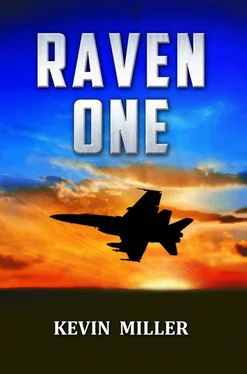Weed then added a typical Weed comment. “It could be worse, you know. If you were a woman, the XO could be after you!”
Shaking his head in disgust, Wilson turned for the door. “Man, you are one sick puppy!”
“I’m thinking Tyra Banks with a big — ah — Adam’s apple.”
“I’m outta here,” Wilson said, still smiling in spite of himself.
“Where ya goin’?” Weed asked.
“Topside for a run.”
“It’s 30 knots up there.”
“Perfect,” Wilson replied.
“Lead’s air speed, angels on the left.” Prince transmitted from a mile abeam.
“Two’s speed ‘n’ angels on the right,” Wilson replied.
“Take a cut away,” Prince ordered.
“Two,” Wilson acknowledged.
With that, both pilots pushed the throttles to military and banked away from each other for the last of three engagements they had briefed for this good deal flight, a 1v1 air combat maneuvering training sortie. This was Wilson’s favorite part of the hop: the neutral setup where both aircraft extend away from each other to build separation and then, on signal, turn back toward one another. The track the airplanes flew on this maneuver resembled a butterfly wing, hence the name, “butterfly set.”
Wilson steadied out on a heading of 210 and scribbled some notes on his kneeboard card, with a drawing of a God’s-eye picture of the two aircraft heading 180, and taking cuts away from each other. He drew a circle to depict the sun ahead of them and wrote the number “60” to indicate 60 degrees up.
Prince was leading because he needed the hop for his flight-lead-under-training syllabus. After 15 months in the squadron, it was time for Prince to become a section leader , the flight lead of two aircraft. Wilson was disappointed with Prince’s performance on this qualification flight. It began with the brief, when Prince did not know the ship had moved south during the night. His perfunctory preflight briefing was nothing more than satisfactory, and his performance on this flight, so far, was unsatisfactory .
In both his offensive and defensive setups Prince had mismanaged his air speed and lift vector. In the first, Prince allowed Wilson to escape when he began the engagement behind him in a firing position. In the next setup, when beginning from a defensive position, Prince was unable to shake Wilson from shooting him with a tracking guns shot. Although Wilson possessed 2,000 more FA-18 hours than Prince, and was a TOPGUN graduate, he was upset. “C ’mon, Prince, pull!” he had muttered as Prince arced above him and let up on the pressure. Wilson liked to win an engagement as much as anyone, but it was as if Prince had been just going through the motions, not challenging Wilson or himself. The two pilots were not friends and there was a clear superior/subordinate relationship, but as Operations Officer Wilson wanted and needed Prince to qualify as section lead to allow more flight scheduling options. After the last fight, as they climbed to altitude, Wilson had radioed a simple comment to him on how to improve his lift-vector placement. Prince had answered with a glum “ Roger .”
An overnight cold front had left behind a gorgeous winter sky, clear and crisp, and the visibility was unlimited from horizon to horizon, rare anytime in the Gulf. From 18,000 feet, Wilson had a clear view of the Saudi coast, with Dhahran off his nose and Bahrain just to the left. Offshore were numerous oil rigs, and the two dominant colors were the blue of the Gulf and the beige of the Arabian land mass. He could see the frontal clouds far to the east over Iran. Wilson loved moments like this: high over the water in a single-seat jet with a sparring partner to bump heads with and log some great training. He remembered how a friend once described air combat training: the sport of kings.
Even if Prince would not give him a good fight, Wilson was ready… no, eager… to kick his ass if he again ignored his advice. No holds barred, full up air combat maneuvering , he thought. This day is too perfect and the fuel too short to waste. Brimming with anticipation, he looked at Prince over his left shoulder some three miles away.
Thirty seconds later Prince broke the silence. “Turnin’ in, tapes on, fight’s on.”
At the “ f ” in “fight’s on,” Wilson slammed the throttles to afterburner and snapped the Hornet over on the left wing in one motion, pulling hard across the horizon in a slightly nose-low energy sustaining pull. “Tapes on, fight’s on,” he responded.
Keeping sight of Prince through the top of his canopy, Wilson pulled hard across the horizon and put the “dot” of Prince’s airplane in the middle of the HUD. The radar locked on and formed a box around the jet 2.5 miles away. Wilson pulled tighter and was on the inside position as they accelerated to the merge. The aircraft were now pointed at each other with air speed building to over 900 knots of closure. By the geometry, Wilson could see a right-to-right pass forming as they approached like knights in a jousting match.
“Right-to-right,” Prince radioed.
“Right-to-right,” Wilson responded, as he pulled the throttles out of burner.
A 1v1 fight with a modern forward-quarter missile threat aircraft like the Hornet calls for a one-circle or pressure fight to stay close and deny the opponent the forward quarter missile, often a heat-seeker like the Sidewinder . In like-performing aircraft the initial move inside was vital to gain angles that allowed one to position the opponent out in front of the canopy, or even to take a gun shot if one presented itself. Such fights often degenerated into slow-speed scissors, or “knife fights,” as the aircraft kept close. They also often ended up with both aircraft groveling at slow speed just above the 5,000-foot “hard deck,” which simulated the ground. Wilson knew he had to pressure Prince, and noted the sun up and to the right. If he pulled hard across Prince’s tail and into the oblique, after 180 degrees of turn he could be inside his turning circle and lost in the sun above him, able to pounce once Prince lost sight. Wilson decided on this strategy in an instant. In essence, he would be toying with Prince instead of pulling hard into him and going for the jugular.
As they drew closer, Prince drifted right on Wilson’s windscreen. The norm was to pass close aboard, 500 feet, but Prince did not correct this drift. The added distance meant turning room for the pilot who was willing to “bite” and take advantage of an early turn to get angles, and Wilson wasn’t going to pass up free angles. You give me room, I’m gonna take it, he thought. With Prince’s Hornet growing and lateral separation building greater than 500 feet, Wilson took a sharp breath— Hookkk! — while tightening his muscles, relit the burner cans and pulled hard into Prince.
Wilson snatched the jet up and to the right at the instant a force of 6.5 times his body weight pushed and squeezed every square inch of him. At the same time, a cloud of white condensation formed on top of the aircraft as he flew into and above Prince’s flight path. Straining to keep sight of Prince over his right shoulder, he sensed the horizon elevate and go perpendicular on the canopy.
To Wilson’s surprise, Prince held his lift vector on as he went up with Wilson. Well, well, Wilson thought, as he watched the outline of the Hornet going up a mile away. Prince is showing some aggressiveness .
Wilson sensed his sun strategy was now superseded by Prince’s nose-high move. He kept his left arm locked against throttles, pushing them against the burner stop as he pulled the nose through the vertical and to the horizon. He rolled into Prince with a boot full of rudder to knuckle his own aircraft down and inside the younger pilot. The horizon rolled underneath Wilson as he reached the apex of his modified loop and put the top of his canopy, his lift vector, on Prince. The dark silhouette of Prince’s Hornet zoomed past less than 500 feet away. Wilson dug his nose down to regain needed air speed, ruddered the jet to the left and kept the top of his airplane facing Prince in a nose-low pirouette.
Читать дальше












